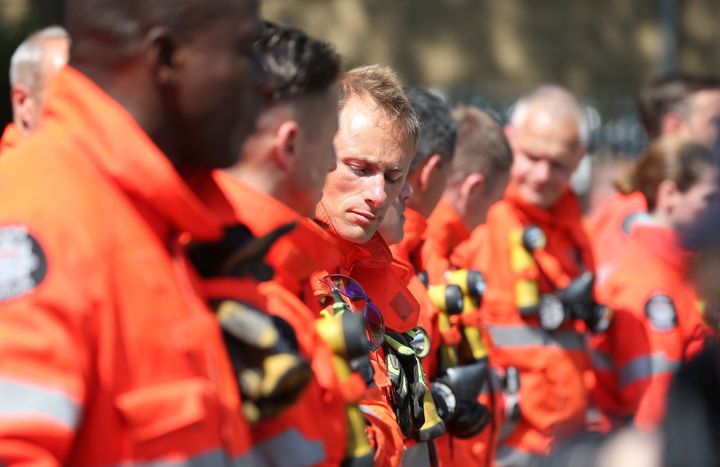
Crucial fire safety tests are carried out on less than one-in-twenty at-risk buildings each year, HuffPost UK has learned as experts warn of a “broken” system of fire safety that should be overhauled in the aftermath of the Grenfell disaster.
Eleven years ago, new legislation was introduced that meant owners of commercial and common parts of residential buildings were responsible for assessing fire risk, shifting the burden away from the state and the fire service, which had issued safety certificates.
But fire safety professionals have told HuffPost UK that the disaster in west London, which killed 80 people, has raised questions over whether the Regulatory Reform (Fire Safety) Order (RRO) is fit for purpose and exposing millions of people to danger.
To ensure buildings are safe, local fire services carry out audits to ensure building owners have carried out fire risk assessments (FRAs) and that they comply with the rules, issuing enforcement notices if they fail to make the grade.
But experts fear a toxic combination of austerity and slashing red tape has rendered self-regulation “pretty much useless” because of problems with enforcement.
They say:
Fire brigade safety officers are struggling to carry out audits because of cuts to their headcount. The Fire Brigades Union (FBU) told HuffPost UK the number of fire safety officers in England is less than half the 1,500 employed in 2006. Officers now audit less than 5% of properties subject to the law each year.
Audits are often “superficial” and just “desktop exercises” which involve little more than reading a written report. They point to the post-Grenfell evacuation of the Chalcots Estate towerblocks in Camden, north London. This was ordered after “enhanced” London Fire Brigade checks found scores of faults that had been previously overlooked, not just because of fears over cladding.
Private sector fire consultants who carry out assessments of complex buildings do not need any qualifications or training, meaning the dangers posed by multi-storey tower blocks and shopping centres can be assessed by anyone.
Deaths caused by fires have fallen to a record low in the last decade, but experts fear some of the reasons driving the trend - such as fewer people smoking and using coal fires - are masking how dangerous buildings are.
Critics are concerned with how regularly assessments are carried out. For example, boilers in rented properties have to be inspected annually by a qualified engineer, but there is no requirement for fire risk assessments to be carried out habitually.
David Sibert, the FBU’s fire safety advisor, told HuffPost UK:
“I’ve described it for years as walking along the cliff edge. We haven’t got the resources anymore to stop these things happening, and so we are building problems into our built environment because we aren’t on top of it anymore.”
The Regulatory Reform Order, introduced by Labour in 2006 and the first major upgrade of fire safety legislation since the 1970s, is to come under scrutiny during the Grenfell Tower fire inquiry, which begins this week. It’s separate from already heavily-criticised building regulations that allowed the tower block to be encased in flammable cladding as part of a multi-million pound refit.
Grenfell’s last FRA was reportedly carried out in June last year, and questions remain how fire safety laws can allow the alleged faults that arguably made the tragedy worse - such as inadequate fire doors and a single staircase - to be overlooked and not raise the alarm over potentially dangerous improvements. As experts told HuffPost UK, too many buildings remained potentially dangerous even after the inquest into the Lakanal House fire in south-east London, which killed six people in 2009, exposed how no fire checks had been carried out.
Those spoken to by HuffPost UK argue self-policing is failing because of cuts to public spending, and official figures bear witness to how smaller budgets are affecting the number of audits fire services can carry out. According to Home Office data, 63,201 fire safety audits were completed in England in 2015/16, or 18 per cent fewer than in 2009/10 when 77,532 audits were done. It is a fraction of the 1.5 million buildings fire authorities know are subject to the law. Buildings are also quite likely to be found at fault, with 30% of those audited deemed “unsatisfactory”.
Sibert says the advent of the RRO meant more buildings were subject to fire safety law but “we’ve got less than half the number of people” to do the job. Fire services are expected by the Government to have a re-inspection programme for the buildings in its area that the order applies to, but he suggested these are “weasel words” given the diminished number of officers.
He says: “You end up inspecting fewer and fewer of your high risk buildings. You’re still inspecting the highest risk ones. You’re still doing what the Government says you must do, you’ve got the risk assessment re-inspection programme. You’re just only inspecting the very highest risk ones.”
He says the most common problems relate to fire walls and doors, while some buildings have not even had a fire risk assessment done in the first place. “That’s a regular thing,” he says. So it could be years before an audit’s carried out? “That is absolutely true, yes.”

Arnold Tarling, a chartered surveyor and a fire safety expert, says he has inspected London towerblocks where problems should have been apparent for more than a decade but have not been picked up by either the assessments or fire service audits. “A lot of the surveys are purely superficial. They just gloss over the surface,” he says.
He details one south London towerblock with rickety external staircases and fire doors that wouldn’t open the right way. “How could that exist several years after the order? How could that exist when fire services were inspecting before that? This has existed for many, many years. That should all have been noticed and dealt with,” he says.
“An audit is a lightweight inspection, basically,” says the FBU’s Sibert, arguing it now mainly involves sitting down with the building manager and going through the written assessment. “They wouldn’t walk around the building to actually see whether or not anything on the fire risk assessment was true. It’s just a desktop exercise.”
Spending less time on audits appears to be a deliberate consequence of the drive to cut regulation. In a report on cutting red tape that argues ‘health and safety’ culture was damaging businesses, the Conservatives boasted how some companies had reduced inspection times from six hours to just 45 minutes.
What happens as a result has come to light after Grenfell, Sibert says. He points to the fact that the towerblocks in Camden were evacuated in June because of incorrectly fitted gas pipes and a litany of faults that included 1,000 missing fire doors, not the cladding encasing the building.
“London Fire Brigade carried out thorough, proper old-fashioned inspections of all of the high-rise buildings in London,” he says. “They’ve been inspected by London Fire Brigade on a number of occasions, but nobody ever picked them up because actually they haven’t been inspected by London Fire Brigade, they’d been audited by London Fire Brigade.” Graham Fieldhouse, another independent expert, thinks the Government should introduce a cost recovery scheme, based on the Health and Safety Executive’s model, so that building owners would be forced to pay for the audit if the property failed to meet the order, reducing the cost on the state.

That fire assessors are unregulated is also “deeply worrying”, says Sibert. When the RRO effectively introduced self-regulation of fire risk in buildings, it also prompted a surge in independent consultants who would charge to carry out assessments for the owners of buildings. Registers and certification exists, but none are mandatory. Sibert explains that the order was set up to be flexible enough so the owner of a small corner shop could do the assessment themselves. But de-regulation is flawed when “the person who carries out the fire risk assessment of a 30-storey block of flats hasn’t even been on a course”.
While there are some “very dodgy” assessors, there are many highly-skilled and reliable consultants, including former fire brigade fire safety assessors, Sibert says. He suggests regulating who can assess the most high-risk buildings, such as high rises and hotels. “It would be quite straight-forward to say that under certain circumstances, the fire risk assessor must be a third-party accredited. That could be done overnight.” Fieldhouse is concerned that some fire assessors have “no idea about safety”, and would like to see a central register of fire risk assessors that have expertise in certain areas. Tarling points to assessors not knowing when alterations have been carried out on buildings as being another fault in the system. He says there can be “total ignorance” of new heating systems and glazing that could pose a fire risk, and turning a blind eye to faults beyond the common areas that are subject to the order. “Buildings that have not been altered from the 1960s and 1970s are far safer than the ones that have. Grenfell and Lakanal would never have happened had they been left as they were.”
He also fears that council housing departments are not carrying out improvements even when problems are identified. “What’s the point of a fire risk assessment if it’s done properly and they don’t act upon it? It’s entirely broken. And when you point out things that are wrong you get attacked.” He goes on: “The RRO is very widely open to interpretation. And they’ll interpret who got something wrong when something goes wrong. It’s not fit for purpose.”
“If you can’t enforce legislation, then it’s pretty much useless having it.””
- David Sibert of the Fire Brigades Union
Sibert suggests governments have overlooked fears over fire safety because of the fall in the number of fires. Indeed, ministers have recently pointed to the number of fire incidents in England being reduced by more than half in the last 10 years. But the FBU says this is as much to do with wider social changes than buildings being safer. “If you do have a fire the risk from that fire to you is exactly the same as it ever was,” Sibert says. “So you need just as many fire engines. The fire service has desperately tried to keep as many fires engines available as it needed, and that has meant that they’ve had to make cuts elsewhere. And that’s in fire safety.”
All that said, Sibert makes clear he thinks the legislation is sound, so long as it is enforced properly. “People do say ‘bring back the Fire Precautions Act’. But if we had just as many officers that we had in the 1990s, the fire safety order is a perfectly good piece of legislation. If you can’t enforce it, then it’s pretty much useless having it.”
Fieldhouse also argues the previous legislation was “too prescriptive”. “What we had before is a little but like an MOT on a car. A building was safe only on the day in question. The RRO made it an ongoing thing - you have to maintain your building to a standard.”
The Government responded by arguing there is “no question” that fire services have funding to carry out the order.
A Home Office spokesperson said: “The Hackitt Review announced its terms of reference at the end of August. It will look at the whole system for building regulations and fire safety and will make recommendations of how to improve the system for the future.
“It is the responsibility of each fire and rescue authority to allocate and manage their resources across prevention, protection and operational response to meet local risk, but there is no question that fire and rescue services still have the resources they need to carry out their work.
“Each fire and rescue authority must have a locally determined risk-based inspection programme and management strategy in place to ensure compliance with the Fire Safety Order’s provisions.”
